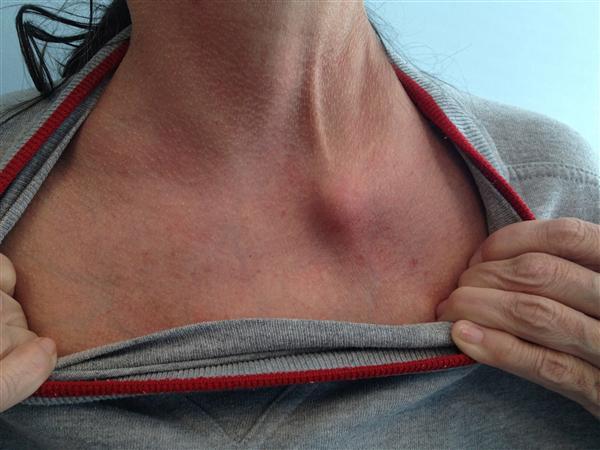Swelling of the sternoclavicular joint is usually caused by quite serious conditions; therefore, it is necessary to visit a doctor soon after you notice this symptom. Also, do not make a diagnosis on your own, which will do more harm than good, as it can delay the treatment.
Causes and Treatments of Sternoclavicular Joint Swelling

1. Osteomyelitis
Osteomyelitis, or the infection of the bone, is a condition that develops as a result of germs reaching a bone through the bloodstream, infection of the tissue that is close by, or bone exposure caused by injury. Common symptoms of this medical condition include:
- High body temperature accompanied with shivering
- Pain around the affected region
- Edema, redness and warm feeling of the infected area
Treatment:
The treatment for osteomyelitis requires surgery, as this is the only way to remove infected and dead bone fragments. The patient needs hospitalization after the surgery, and antibiotics will be administered.
Before an antibiotic is prescribed, biopsy of the bone is necessary to make sure which germ is causing the infection. Most of the cases, antibiotics are introduced into the body through the vein in the forearm, and the treatment usually lasts 4 to 6 weeks. After a successful treatment by intravenous antibiotics, the medical professional will prescribe some oral ones if the patient is dealing with a more serious type of infection.
2. Rheumatoid Arthritis
One of the causes of sternoclavicular joint swelling can be rheumatoid arthritis, an autoimmune disorder that develops when your immune system starts mistaking your own tissues for foreign ones and begins to attack them.
This condition directly affects joint's lining, which, as a result, causes painful and uncomfortable swelling that oftentimes leads to deformity of the joint, along with the erosion of the bone. Some of the symptoms of this autoimmune disorder include but are not limited to:
- Warm, edematous joints
- Stiffness of joints that is worse in the morning
- Weight loss, high body temperature, and weariness
Treatment:
Even though there is currently no cure for this disorder, recent studies have shown that if the treatment begins early on, remission of symptoms is entirely possible.
Medications used to treat rheumatoid arthritis are very strong and are known by the name of disease-modifying antirheumatic drugs (DMARDs). These include leflunomide (Arava), methotrexate (Rasuvo, Trexall), and sulfasalazine (Azulfidine).
3. SAPHO Syndrome
SAPHO syndrome is a disorder that affects not only joints but also bones and skin. SAPHO stands for:
- Synovitis (Joint inflammation)
- Acne
- Pustulosis (Yellow-colored blisters that contain pus and appear on the soles and palms)
- Hyperostosis (Bone substance increasing)
- Osteitis (Bone inflammation)
Treatment:
This chronic condition that causes sternoclavicular joint swelling doesn't have a particular drug treatment since it has a tendency of self-healing. However, some rheumatologists do prescribe sulfonamides and nonsteroidal anti-inflammatory medications to subdue joint symptoms. Some other drugs can be used too, and they are:
- Methotrexate
- Infliximab
- Calcitonin
- Etanercept
- Systemic corticosteroids
- Topical corticosteroids
4. Aneurysmal Bone Cyst
Aneurysmal bone cyst, otherwise known as ABC, is a neoplasm, or a benign bone tumor. It is made of a multiloculated cavity that is filled with blood and a fibrous lining that is quite thick. The lining itself consists of capillaries, mesenchymal spindle cells, enormous cells with more than one nucleus, and sometimes even premature reactive formation of the bone. Symptoms of this tumor include:
- Mild ache
- Edema
- Expansile accumulation that is tangible
Treatment:
Inactive lesions can be treated successfully with the help of curettage; however, for active lesions, curettage is not enough as the rate of recurrence is very high. Thankfully, marginal resection has proven to be an effective ABC treating method, if combined with the usage of liquid nitrogen, methyl methacrylate, and phenol which all have the ability to kill pathogenic cells at edges of the resected cyst.
5. Sternoclavicular Joint Arthritis
If you have experienced any sprain, fracture or dislocation of the sternoclavicular joint, your cartilage and ligaments that are keeping it in place have also suffered a bit of trauma. After a while, as a result of these injuries, or simply due to the dreadful process that is aging, the cartilage starts becoming thinner and sternoclavicular (SC) joint arthritis occurs, accompanied with occasional sternoclavicular joint swelling.
Some of the other symptoms of this arthritis are a constant, dull pain in the SC area, rigidness of the collarbone region, and weak shoulders.
Treatment:
The above-mentioned symptoms can be well treated with the help of rest, medications and applied heat. Physical therapy is also of great assistance since it allows patients to regain their strength and ability to move painlessly. In some cases, ache and other symptoms persist even after trying various treating methods, and only surgery can help in these conditions.
